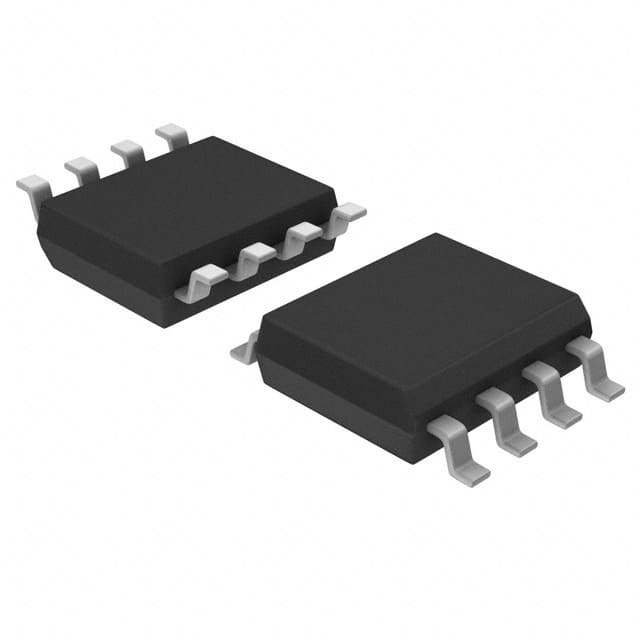Xem thông số kỹ thuật để biết chi tiết sản phẩm.

X9318WS8
Product Overview
- Category: Integrated Circuit (IC)
- Use: Digital Potentiometer
- Characteristics:
- Non-volatile memory
- 100 tap points
- Low power consumption
- Wide operating voltage range
- Package: WS8 package
- Essence: X9318WS8 is a digital potentiometer IC that provides non-volatile memory and precise resistance adjustment capabilities.
- Packaging/Quantity: Available in tape and reel packaging, with a quantity of 2500 units per reel.
Specifications
- Resistance Range: 0 to 10kΩ
- Tap Points: 100
- Operating Voltage Range: 2.7V to 5.5V
- Temperature Range: -40°C to +85°C
- Interface: Serial (SPI) interface
- Memory: Non-volatile EEPROM memory for storing wiper position
Detailed Pin Configuration
The X9318WS8 IC has the following pin configuration:
- VCC: Power supply voltage input
- H: High voltage terminal of the resistor array
- W: Wiper terminal of the resistor array
- L: Low voltage terminal of the resistor array
- CS: Chip select input for SPI communication
- SCK: Serial clock input for SPI communication
- SI: Serial data input for SPI communication
- SO: Serial data output for SPI communication
- GND: Ground reference
Functional Features
- Precise resistance adjustment through digital control
- Non-volatile memory allows the device to retain the wiper position even when powered off
- SPI interface enables easy integration with microcontrollers and other digital systems
- Low power consumption ensures energy efficiency
- Wide operating voltage range allows compatibility with various power supply configurations
Advantages and Disadvantages
Advantages: - Non-volatile memory ensures the preservation of wiper position - Precise resistance adjustment with 100 tap points - Low power consumption for energy-efficient applications - Wide operating voltage range provides flexibility in power supply options
Disadvantages: - Limited resistance range (0 to 10kΩ) - Requires SPI interface for control, which may add complexity to the system design
Working Principles
The X9318WS8 digital potentiometer operates by using a resistor array and a wiper terminal. The resistance between the wiper terminal and either the high or low voltage terminal can be adjusted digitally through the SPI interface. The non-volatile EEPROM memory stores the wiper position, allowing it to be retained even when the power is turned off.
Detailed Application Field Plans
The X9318WS8 digital potentiometer finds applications in various fields, including:
- Audio Systems: Volume control, tone adjustment, and equalization circuits.
- Instrumentation: Calibration and fine-tuning of measurement equipment.
- Industrial Control: Setting reference voltages, controlling motor speed, and adjusting signal levels.
- Communication Systems: Signal conditioning, impedance matching, and gain control.
- Consumer Electronics: Display brightness control, contrast adjustment, and user interface customization.
Detailed and Complete Alternative Models
- X9C103S: Similar digital potentiometer IC with a smaller package size (SOP-8).
- MCP4131: Digital potentiometer IC with higher resolution (256 tap points) and I2C interface.
- AD8403: Digital potentiometer IC with multiple channels (quad-channel) and parallel interface.
These alternative models offer different features and specifications, providing options based on specific application requirements.
Word count: 410 words
Liệt kê 10 câu hỏi và câu trả lời thường gặp liên quan đến ứng dụng X9318WS8 trong giải pháp kỹ thuật
Sure! Here are 10 common questions and answers related to the application of X9318WS8 in technical solutions:
Q: What is X9318WS8? A: X9318WS8 is a digital potentiometer IC (integrated circuit) that can be used to digitally control resistance in various electronic circuits.
Q: How does X9318WS8 work? A: X9318WS8 works by using digital signals to adjust its internal resistance, allowing precise control over the output voltage or current in a circuit.
Q: What are the key features of X9318WS8? A: Some key features of X9318WS8 include non-volatile memory, low power consumption, wide operating voltage range, and small package size.
Q: In what applications can X9318WS8 be used? A: X9318WS8 can be used in a wide range of applications such as audio equipment, instrumentation, industrial control systems, and consumer electronics.
Q: Can X9318WS8 replace traditional mechanical potentiometers? A: Yes, X9318WS8 can be a suitable replacement for mechanical potentiometers as it offers more precise and reliable control over resistance.
Q: How do I interface X9318WS8 with a microcontroller or other digital devices? A: X9318WS8 can be easily interfaced with microcontrollers or digital devices using standard communication protocols like I2C or SPI.
Q: Can X9318WS8 be used in high-temperature environments? A: X9318WS8 has a specified operating temperature range, typically up to 85°C, so it may not be suitable for extremely high-temperature environments.
Q: Is X9318WS8 resistant to electrical noise? A: X9318WS8 has built-in noise filtering mechanisms, but it is still recommended to take proper precautions to minimize electrical noise in the circuit.
Q: Can X9318WS8 be used in battery-powered devices? A: Yes, X9318WS8 is designed to operate with low power consumption, making it suitable for battery-powered devices where power efficiency is crucial.
Q: Are there any specific design considerations when using X9318WS8? A: Some design considerations include proper decoupling of power supply, ensuring appropriate voltage levels, and following the manufacturer's guidelines for layout and thermal management.
Please note that these answers are general and may vary depending on the specific requirements and application of X9318WS8 in a technical solution.

